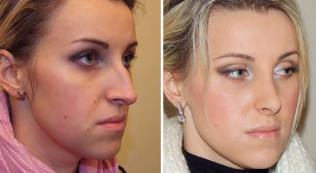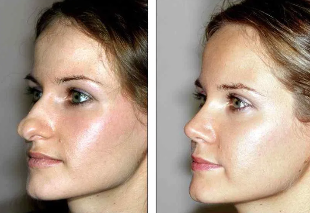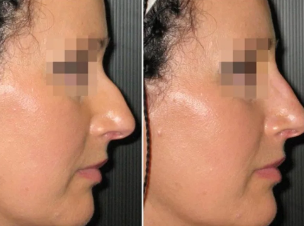Rhinoplasty is one of the most popular plastic surgeries, which involves the manipulation of the nose. The objective of this procedure is to restore the proper shape of the nose, which was broken as a result of injury, disease or congenital abnormalities.
The history of the development

You may think that rhinoplasty is a recent invention, and use the services of surgeons completely alone stars and models. This is not so. The first mention of the technique of recovery of the nose dates back to antiquity. Similar operations were carried out in India for 1000 years BC Indian doctors had repaired the damaged noses, taking skin from the cheek of the patient.
In Europe, the rhinoplasty was developed in the Middle ages. Italian surgeons described their own method of reproducing the shape of the nose from the skin. In the 19th century, this kind of operations has received new impetus, thanks to the efforts of English and German doctors. There are new methods, based on the experience of Indian surgeons.
First, the purpose of the rhinoplasty was to repair the nose, cosmetic and aesthetic factors have gained importance in the late 20th century.
Medical indications for rhinoplasty
Any plastic surgery can be called a creative process, and rhinoplasty is no exception. It combines the solution of an aesthetic problem with the restoration or preservation of the functions of the authority (normal nasal breathing).
Thus, this intervention may pursue both therapeutic and aesthetic purposes. It is best to do the surgery at the age of 25-30 years, when the cartilage is fully formed. Of course, the recommended age may vary depending on individual circumstances.
Medical indications:
- Violation of nasal breathing or complete lack of it.
- Traumatic injuries that resulted in changes and deformation of cartilage and bones.
- Physiological and compensatory curvature of the nasal septum.
- Congenital curvature or deformity of the nasal septum.
- Cysts and polyps in the nose.
- Hypertrophy of the turbinates.
Violation of the anatomical structure of the nose and lead to various functional disorders and pathological conditions. This may include: otitis media, rhinosinusitis, asthma, snoring, frequent respiratory infections, atrophy or hypertrophy of the membranes of the nose, difficulty in nasal breathing.
Especially dangerous violation of nasal breathing for children. It can cause oxygen starvation of the brain, leading to mental and physical developmental delays. The operation to restore the respiratory function can be assigned to 18.
Aesthetic indications for rhinoplasty
More than half of the operations change the shape of the nose done for cosmetic reasons. Patients want to achieve harmony in your appearance. Aesthetic indications for plastic surgery can be divided into two subgroups:
- Objective. When the nose is disproportionate in size, shape.
- Subjective. This subgroup includes, above all, psychological reasons related to the assessment of their appearance. For example, patient like a small hillock or upturned.
Psychological causes are often associated with professional or social environment. The patient has complexes, an acute dissatisfaction with their appearance.
Aesthetic indications:
- The deviated septum.
- Acquired and congenital deformities.
- The disproportionate size relative to the face when the nose seems too large or too small.
- Saddle nose shape.
- Bump.
- Too wide nostrils.
- Unattractive form when the tip of the nose forked, lowered, raised, thickened, or pointed.
- Asymmetrical nose.
- Correction of the consequences of a failed rhinoplasty.
It is important to understand that the result of the operation is not always possible to obtain a perfect result. In surgery, there are limitations, therefore rhinoplasty should be seen as a correction of an existing form.
Contraindications

Before surgery, many patients are advised to see a psychologist. There are cases when the patient has a normal shape of the nose without aesthetic or functional disorders. Then the problem will be solved after working with the psychologist.
A plastic surgeon may conduct a special measurements, and to say exactly whether there are defects. There are certain parameters by which to assess how the shape of the nose and the harmony of its position relative to the forehead, eyes, mouth, chin, ears. On the advice of a doctor, you can simulate on the computer the alleged appearance after surgery.
Contraindications:
- Age limits. Surgery is not recommended before 18 and after 40 years. These restrictions can be taken for objective reasons.
- Diabetes, kidney disease, liver, cardiovascular system.
- Folliculitis and acne in the nose area.
- The clotting of blood.
- Oncology.
- Mental illness.
- The period of menstruation.
Types of rhinoplasty
Depending on the objectives and techniques of performing the surgical intervention rhinoplasty is divided into several types.
Goals for rhinoplasty may be:
- Reconstructive. This recovery of violations, which arose due to diseases, injuries, defects and fetal development.
- Aesthetic. This is a correction of cosmetic defects.
During the operation can be carried out:
- Increase or decrease of the nose.
- The elimination of the hump.
- Correction of saddle-shaped nose, that is, the elimination of recess.
- Correction of the shape of the tip of the nose.
- Septoplastike (correction of nasal septum).
- Post-traumatic reconstruction.
According to the method of access surgery can be open and closed. Private method used in aesthetic operations, since it is less traumatic. In this case, all incisions are made inside the nasal cavity. The skin is separated from cartilage and the surgeon can easily adjust the form to work with bone and cartilage tissue, to remove excess or increase with implants. After manipulating the breakdown neatly filed.
Open rhinoplasty is used in difficult cases, to correct serious changes and execute large-volume transactions. The cut is made at the skin crease between the wings of the nose. In this case, the surgeon good access to the tissues, cartilage and bones. Healing with this method takes longer, is still noticeable postoperative scar.
Non-surgical rhinoplasty
Non-surgical rhinoplasty is not an alternative to surgical intervention. However, there are methods available to correct minor flaws.
Rhinoplasty with fillers (cosmetic gel) will help to correct slight imperfections, soften sharp angles, restore symmetry, to change the shape of the tip. The use of fillers allows you to disguise a small bump, to remove the hollowness, to round out the tip.
The recovery period after surgery is easier, the price is low in comparison with the full-fledged operation. However, the effect of the fillers will continue only for a few months (maximum 1.5 year). In some cases, the injection is formed fibrous tissue, and the external effect of the procedure lasts for many years. But often requires a second procedure. There is a complication: migration of the introduced gel and a change in the structure of fabrics after repeated injections.
With the help of injections not only increase, but also to remove the tissue. There are preparations on a hormonal basis, which can eliminate bumps, bulges and even in some cases the hump. With the introduction of these drugs is very important to be careful. Often the procedure is performed in several stages. After 2-3 weeks there will be a significant result.
With the help of special threads you can adjust the shape of the wings of the nose and even pull up the tip. Set of thread through the pinholes that can form scars. Thread may break due to the mobility of the nose. For these reasons, surgeons rarely resort to such a procedure.

Preparing for surgery
For a successful operation requires the cooperation of the patient and the doctor. Before the intervention of the consultation where the surgeon will explain to the patient that he will be to achieve the desired result.
Joint studies are being conducted: a blood test, a study of its coagulation, urinalysis, ECG, tests for HIV, hepatitis, syphilis.
If necessary, conducted a special study, is the. If you have a chronic illness, you need to consult a GP or relevant specialist. The intervention will be postponed in case of aggravation of chronic diseases, the occurrence of acute respiratory diseases or infectious skin lesions. Before surgery you will meet with the anesthesiologist.
Your doctor may recommend to abstain from alcohol, Smoking, eliminate junk food, stop taking sleeping pills and sedatives. Two weeks before the intervention is required to stop taking aspirin and its analogues.
Complications
Rhinoplasty is one of the most complex plastic surgery as an important aesthetic and functional side. Complications arise depending on various factors in 4-15% of patients. They can be divided into operational and aftercare.
Operative complications:
- bleeding;
- breaks in the skin;
- violation of the integrity or fractures of the bones;
- separation of the cartilage flap, etc.
Postoperative complications:
- loss of smell;
- loss or reduction of sensitivity of the nose and lower lip;
- obstruction of nasal breathing;
- atrophic rhinitis;
- deterioration corrected cosmetic lack of changes;
- psychological complications (patient does not accept changes in appearance, he doesn't like the new face);
- swelling of the nose and eyes, inflammation, suppuration;
- pigmentation of the skin, scar formation, capillary network;
- frequent or prolonged nosebleeds;
- necrosis.
The most dangerous complication that can occur during the rhinoplasty is an allergic reaction to anesthesia. Anaphylactic shock can cause death in 20% of cases.
The recovery period
The patient can leave the hospital within a few hours after the surgery or stay overnight for observation. Major recovery after the correction of the nose lasts for 3 weeks. Full restoration will come only after six months or a year.
The seams and plaster Longuet will be removed in 1.5 weeks. Another 2 weeks it will be possible to take a hot bath, wash your face with hot water – it can cause bleeding, bruising, swelling of the face and neck. Need to sleep on the back reclining. You cannot bend, lift weights. In dusty areas should wear a mask.
Within three months should be thoroughly protected from bumps and pressure on the nose, do not wear glasses, masks, hard hats. It is prohibited to use the pool and sunbathe. The surgeon may also impose other restrictions dictated by the individual patient's condition.
The results of the operation
The healing of cartilage and bone tissue takes several months. The final result is the surgeon and the patient will be able to evaluate after about 8 months. The decision to do a rhinoplasty (especially if do not exist already quite explicit testimony) may be perceived negatively, therefore, the patient should be prepared for mixed reactions from family and friends.
Relatives may be unhappy with the loss of a family or ethnic traits. However, often the patient himself and his family, I do not notice much effect from such an operation, because the swelling hides the changes appear gradually.
Rhinoplasty can be quite change the appearance, but do not think that using plastic surgery is possible without restrictions to model everything seems in fantasy. Any surgery is a dangerous thing, can lead to complications and even worsening of the defect. Therefore, to treat such intervention should be seriously, carefully weighing the possible benefits and the risk of negative consequences.




















